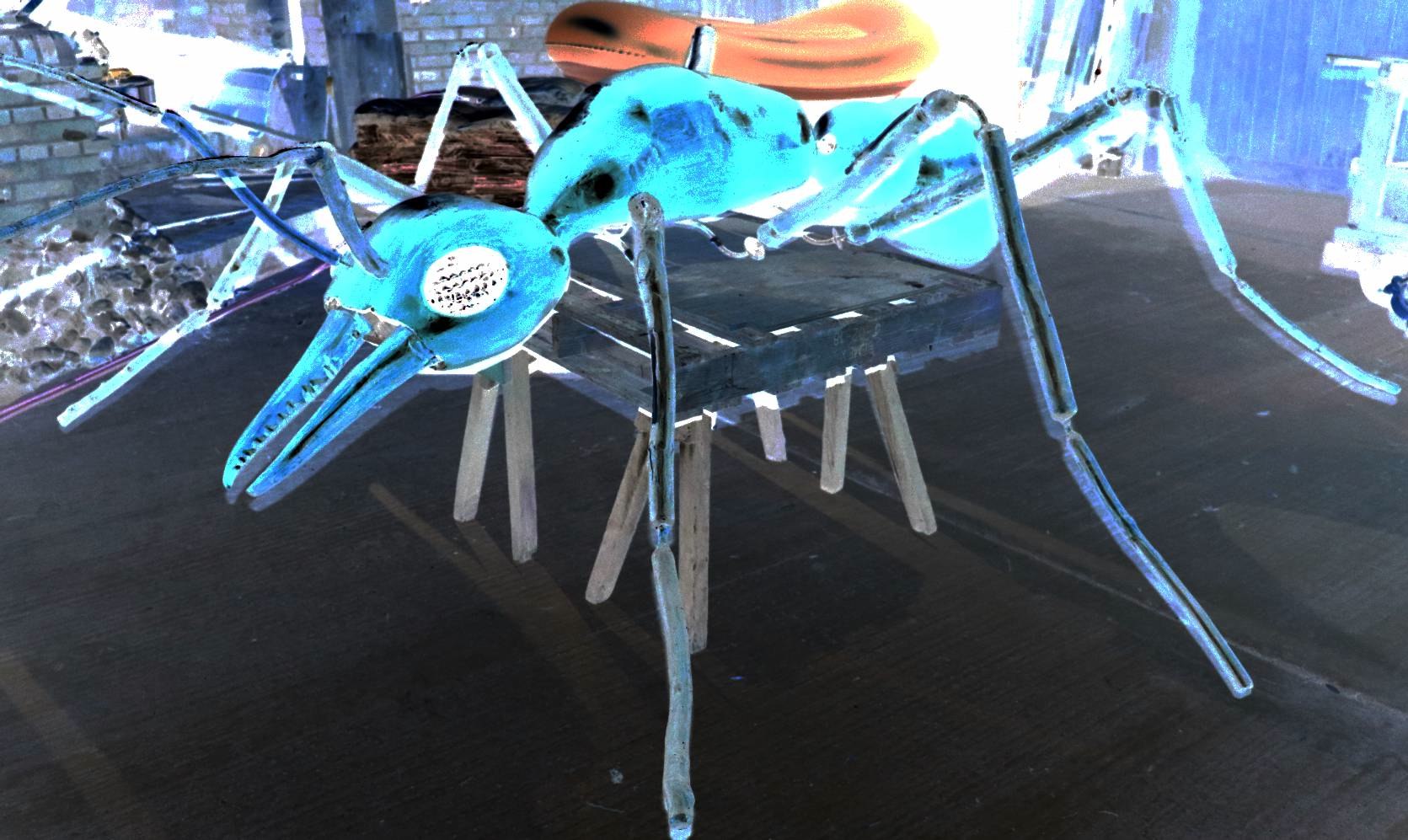
A misconception commonly portrayed in popular books and media is that all the dinosaurs died out at the same
time - and apparently quite suddenly - at the end of the Cretaceous Period, 66 million years ago. This is not entirely correct, and not only because birds are a living branch of dinosaurian lineage.
The best records, which are almost exclusively from North America, show that dinosaurs were already in decline during the latest portion of the Cretaceous. The causes of this decline, as well as the fortunes of other groups at the time, are complex and difficult to attribute to a single source. In order to understand extinction, it is necessary to understand the basic fossil record of dinosaurs.
Most of the
evidence of prehistoric Life
on Earth is fossilized. Though some exists in DNA today. Could there
have been another explanation? Perhaps involving animals such as larger insects
that had evolved to resist extremely cold conditions, climate
change, and perhaps the dinosaurs were not so adaptable and so
perished.
It
is theoretically possible for giant insects to have progressed, so that as the weather patterns changed from volcanic to
freezing snow and ice, that only the creatures that had modified their
blood chemistry to be resistant to the cold, would outlive warm blooded
dinosaurs, after the cataclysmic extinction event that saw the earth endure a
winter, about 66 million years ago. About which cause, there is much speculation in the scientific community.

Several animals have an anti-freeze protein in their blood. This includes arctic and antarctic fish, arthopods, octopuses, painted turtle hatchlings, wood frogs, arctic ground squirrels (the only mammal), some beetles, moths, bacteria, and the champions- tardigrades or water bears . They have handled lab temps from -278°C (-458°F) up to 150°C (300°F). Some tardigrades frozen in 1983 were thawed out 30 yrs later and not only survived, but could reproduce. It’s been estimated that they can withstand being dried out and will rehydrate and do okay after about 100 yrs. They have also gone into space and tolerated lack of oxygen and radiation.
OCTOBER 31 2023
- TOP SCIENTISTS SAY 'REAL' CAUSE OF DINOSAUR EXTINCTION WAS DUE
TO 'NUCLEAR WINTER'
Scientists have revealed that the dinosaurs were not made extinct by an asteroid colliding with
earth.
Experts have analysed dust particles in the United States and have made a major find in the search to explain the annihilation of the giant beasts.
A team of experts, led by the Royal Observatory of Belgium, have determined that debris from the asteroid was thrown into the earth’s atmosphere, blocking the light of the sun thereby preventing the process of photosynthesis needed for plants to survive.
The amount of dust generated, the experts believe, was approximately 2,000 gigatonnes. That’s 11 times the weight of Mount Everest.
The dust is said to have lingered in the atmosphere for as long as 15 years, causing a global nuclear winter.
The lack of sunlight would have prevented the survival of plants and as a result herbivores would have died out too. Many herbivores were dinosaurs and scientists believe this protracted period without sunlight explains their extinction.
Such was the scale of the natural catastrophe that 75 percent of living creatures on earth are believed to have been wiped out by the long winter.
Scientists had been stumped by the mystery of the dinosaur extinction, following the discovery of the Chicxulub Crater in 1978.
However, the giant asteroid and the 110-mile crater it left was not sufficient to conclude that that’s what made the dinosaurs extinct.
The previous theory was that sulphur from the impact of the asteroid, or soot from the global fires it created, blocked the light of the sun and condemned the planet to a long painful winter.
However the new findings point to the dust from the asteroid being responsible for the prolonged lightless period.
The dust particles scientists analysed were located at the Tanis fossil site in the US state of North Dakota.
University of Texas geophysicist Sean Gulick, who was not involved in the research, told AFP that the study was yet another interesting attempt to answer the “hot question” of what drove the impact of nuclear winter. However he pointed out that it did not give a definitive answer.
He said that understanding the extinction events of the past may be useful in understanding future extinction threats.
Gulick added: “Maybe we can better predict our own mass extinction that we're probably in the middle of”.
By Max Parry
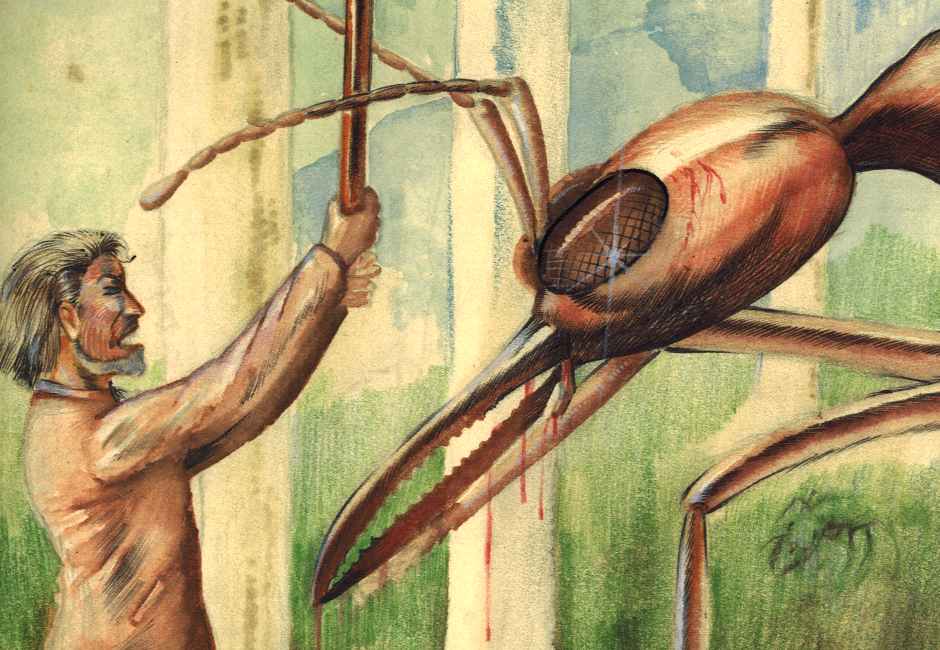
Taken
by surprise, and a knee jerk reaction, John goes to attack the Sectasaur,
before realising they have a rapport.
The Cretaceous-Tertiary extinction event, or the K-T event, is the name given to the die-off of the dinosaurs and other species that took place some 65.5 million years ago. For many years, paleontologists believed this event was caused by climate and geological changes that interrupted the dinosaurs’ food supply. However, in the 1980s, father-and-son scientists Luis (1911-88) and Walter Alvarez (1940-) discovered in the geological record a distinct layer of iridium–an element found in abundance only in space–that corresponds to the precise time the dinosaurs died. This suggests that a comet, asteroid or meteor impact event may have caused the extinction of the dinosaurs. In the 1990s, scientists located the massive Chicxulub Crater at the tip of Mexico’s Yucatán Peninsula, which dates to the period in question.
Dinosaurs roamed the earth for 160 million years until their sudden demise some 65.5 million years ago, in an event now known as the Cretaceous-Tertiary, or K-T, extinction event. (“K” is the abbreviation for Cretaceous, which is associated with the German word “Kreidezeit.”) Besides dinosaurs, many other species of mammals, amphibians and plants died out at the same time.
Over the years, paleontologists have proposed several theories for this extensive die-off. One early theory was that small mammals ate dinosaur eggs, thereby reducing the dinosaur population until it became unsustainable. Another theory was that dinosaurs’ bodies became too big to be operated by their small brains. Some scientists believed a great plague decimated the dinosaur population and then spread to the animals that feasted on their carcasses. Starvation was another possibility: Large dinosaurs required vast amounts of food and could have stripped bare all the vegetation in their habitat. But many of these theories are easily dismissed. If dinosaurs’ brains were too small to be adaptive, they would not have flourished for 160 million years. Also, plants do not have brains nor do they suffer from the same diseases as animals, so their simultaneous extinction makes these theories less plausible.
For many years, climate change was the most credible explanation for the dinosaurs’ demise. Dinosaurs thrived in the planet’s consistently humid, tropical climate. But in the late Mesozoic Era that corresponds with the extinction of the dinosaurs, evidence shows that the planet slowly became cooler. Lower temperatures caused ice to form over the North and South poles and the oceans to become colder. Because the dinosaurs were cold-blooded–meaning they obtained body heat from the sun and the air–they would not have been able to survive in significantly colder climates. Yet some species of cold-blooded animals, such as crocodiles, did manage to survive. Also, climate change would have taken tens of thousands of years, giving the dinosaurs sufficient time to adapt.
IT CAME FROM OUTER SPACE
In 1956, Russian astronomer Joseph Shklovsky (1916-85) became the first scientist to consider the extinction was due to a single catastrophic event when he theorized that a supernova (the explosion of a dying star) showered the earth in radiation that could have killed the dinosaurs. Once again, the problem with the theory was explaining why dinosaurs died out and other species did not. Also, scientists said that such an event would have left evidence on the surface of the earth–trace amounts of radiation dating back to the Cretaceous Period. None was found.
Enter Luis Alvarez, a Nobel Prize-winning physicist, inventor and pioneer in the field of radiation and nuclear research. He and his son, noted geologist Walter Alvarez, were conducting research in Italy when they discovered a centimeter-thick layer of iridium-enriched clay at the K-T boundary. Iridium is rare on earth, but more common in space. The Alvarezes published their findings in 1981, postulating that the thin layer of iridium was deposited following the impact of a large meteor, comet or asteroid with the earth. Furthermore, this bolide impact (the meteor, comet or asteroid colliding with the earth’s surface) could have caused the extinction of the dinosaurs. At the time, the Alvarez theory was so far removed from prevailing hypotheses that it was ridiculed. Slowly, though, other scientists began finding iridium evidence at various places around the globe that corroborated the Alvarez theory. There was, however, no smoking gun in the form of an impact site.
Then in 1991, a massive meteor crater 110 miles in diameter was discovered on the edge of the Yucatán Peninsula, extending into the Gulf of Mexico. The Chicxulub Crater, as it was dubbed, was named for a nearby village. Scientists believe the bolide that formed it was roughly 6 miles in diameter, struck the earth at 40,000 miles per hour and released 2 million times more energy than the most powerful nuclear bomb ever detonated. The heat would have broiled the earth’s surface, ignited wildfires worldwide and plunged the planet into darkness as debris clouded the atmosphere. Miles-high tsunamis would have washed over the continents, drowning many forms of life. Shock waves would have triggered earthquakes and volcanic eruptions.
The resulting darkness could have lasted for months, possibly years. It would have plunged the earth’s temperatures into the freezing zone, killing plants and leaving herbivores with nothing to eat. Many dinosaurs would have died within weeks. The carnivores who feasted on the herbivores would have died a month or two later. Overall, the loss of biodiversity would have been tremendous. Only small scavenging mammals that could burrow into the ground and eat whatever remained would have survived. The iridium layer plus the Chicxulub Crater were evidence enough to convince many scientists that the bolide impact theory was credible. It explained much of what previous theories could not.
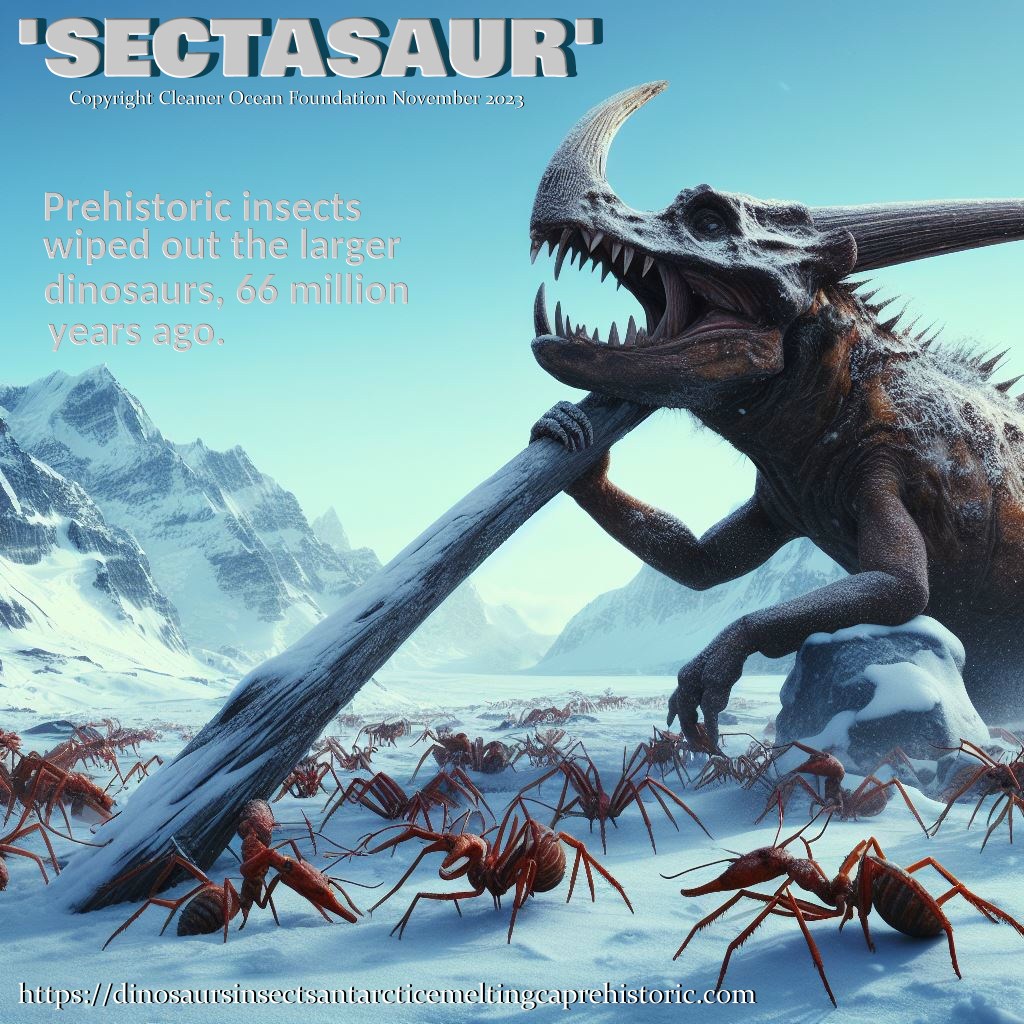
Prehistoric
giant insects, wipe out the larger animals on earth, 66 million years
ago BC,
when food became scarce, and the temperatures plummeted.
STILL A THEORY
Paleontology remains a competitive discipline even though its central mystery appears to have been solved. Agreement over dinosaur extinction is far from unanimous, and fossils continue to be found that add to the body of knowledge about how the dinosaurs lived and died. Only recently have birds been identified as descendants of the dinosaurs, and theories regarding dinosaur intelligence and behavior continue to change. Even long-established truths such as dinosaurs’ cold-bloodedness are open for debate. The climate change theory still holds sway over some scientists, who refute that the Chicxulub impact was the sole cause of the extinction. Evidence from the 65-million-year-old lava flows in India hint that a giant, gaseous volcanic plume might have initiated global climate change that threatened the dinosaurs. Scientists’ continued research will help paint a more detailed picture of the ever-changing, ever-evolving planet.

The
artwork is also suitable for use in "Jimmy Watson's Magic Dinobot."
A proposed network TV serialization, about boy who saves his paper round
money to buy himself a robot for Christmas. Then, when assembled, it
come to life, to become his friend.
THE ASTEROID THEORY
The discovery of an abnormally high concentration of the rare metal iridium at, or very close to, the K–T boundary provides what has been recognized as one of those rare instantaneous geologic time markers that seem to be worldwide. This iridium anomaly, or spike, was first found by Walter Alvarez in the Cretaceous–Tertiary stratigraphic sequence at Gubbio, Italy, in the 1970s. The spike has subsequently been detected at hundreds of localities in Denmark and elsewhere, both in rock outcrops on land and in core samples drilled from ocean floors. Iridium normally is a rare substance in rocks of Earth’s crust (about 0.3 part per billion). At Gubbio the iridium concentration is more than 20 times greater (6.3 parts per billion), and it exceeds this concentration at other sites.
Because the levels of iridium are higher in meteorites than on Earth, the Gubbio anomaly is thought to have an extraterrestrial explanation. If this is true, such extraterrestrial signatures will have a growing influence on the precision with which geologic time boundaries can be specified. The level of iridium in meteorites has been accepted as representing the average level throughout the solar system and, by extension, the universe. Accordingly, the iridium concentration at the K–T boundary is widely attributed to a collision between Earth and a huge meteor or asteroid. The size of the object is estimated at about 10 km (6.2 miles) in diameter and one quadrillion metric tons in weight; the velocity at the time of impact is reckoned to have been several hundreds of thousands of kilometres per hour. The crater resulting from such a collision would be some 100 km or more in diameter. Such an impact site (called an astrobleme) is the Chicxulub crater, in the Yucatán Peninsula. A second, smaller impact site, which predates the Chicxulub site by about 2,000 to 5,000 years, appears at Boltysh in Ukraine. Its existence raises the possibility that the K–T boundary event resulted from multiple extraterrestrial impacts.
Although the amount of iridium dispersed worldwide was more consistent with the impact of a smaller object, such as a comet, the asteroid theory is widely accepted as the most probable explanation of the K–T iridium anomaly. The asteroid theory does not, however, appear to account for all the paleontological data. An impact explosion of this kind would have ejected an enormous volume of terrestrial and asteroid material into the atmosphere, producing a cloud of dust and solid particles that would have encircled Earth and blocked out sunlight for many months, possibly years. The loss of sunlight could have eliminated photosynthesis and resulted in the death of plants and the subsequent extinction of herbivores, their predators, and scavengers.
The K–T mass extinctions, however, do not seem to be fully explained by this hypothesis. The stratigraphic record is most complete for extinctions of marine life—foraminifers, ammonites, coccolithophores, and the like. These apparently died out suddenly and simultaneously, and their extinction accords best with the asteroid theory. The fossil evidence of land dwellers, however, suggests a gradual rather than a sudden decline in dinosaurian diversity (and possibly abundance). Alterations in terrestrial life seem to be best accounted for by environmental factors, such as the consequences of seafloor spreading and continental drift, resulting in continental fragmentation, climatic deterioration, increased seasonality, and perhaps changes in the distributions and compositions of terrestrial communities. But one phenomenon does not preclude another. It is entirely possible that a culmination of ordinary biological changes and some catastrophic events, including increased volcanic activity, took place around the end of the Cretaceous.
THE K-T BOUNDARY EVENT
It was not only the dinosaurs that disappeared 66 million years ago at the Cretaceous–Tertiary, or K–T, boundary (also referred to as the Cretaceous–Paleogene, or K–Pg, boundary). Many other organisms became extinct or were greatly reduced in abundance and diversity, and the extinctions were quite different between, and even among, marine and terrestrial organisms. Land plants did not respond in the same way as land animals, and not all marine organisms showed the same patterns of extinction. Some groups died out well before the K–T boundary, including flying reptiles (pterosaurs) and sea reptiles (plesiosaurs, mosasaurs, and ichthyosaurs). Strangely, turtles, crocodilians, lizards, and snakes were either not affected or affected only slightly. Effects on amphibians and mammals were mild. These patterns seem odd, considering how environmentally sensitive and habitat-restricted many of these groups are today. Many marine
groups - such as the molluscan ammonites, the belemnites, and certain bivalves—were decimated. Other greatly affected groups were the moss animals (phylum Bryozoa), the crinoids, and a number of planktonic life-forms such as foraminifers, radiolarians, coccolithophores, and diatoms.
Whatever factors caused it, there was undeniably a major, worldwide biotic change near the end of the Cretaceous. But the extermination of the dinosaurs is the best-known change by far, and it has been a puzzle to paleontologists, geologists, and biologists for two centuries. Many hypotheses have been offered over the years to explain dinosaur extinction, but only a few have received serious consideration. Proposed causes have included everything from disease to heat waves and resulting sterility, freezing cold spells, the rise of egg-eating mammals, and X-rays from a nearby exploding supernova. Since the early 1980s, attention has focused on the so-called asteroid theory put forward by the American geologist Walter Alvarez, his father, physicist Luis Alvarez, and their coworkers. This theory is consistent with the timing and magnitude of some extinctions, especially in the oceans, but it does not fully explain the patterns on land and does not eliminate the possibility that other factors were at work on land as well as in the seas.
One important question is whether the extinctions were simultaneous and instantaneous or whether they were nonsynchronous and spread over a long time. The precision with which geologic time can be measured leaves much to be desired no matter what means are used (radiometric, paleomagnetic, or the more traditional measuring of fossil content of stratigraphic layers). Only rarely does an “instantaneous” event leave a
worldwide - or even regional - signature in the geologic record in the way that a volcanic eruption does locally. Attempts to pinpoint the K–T boundary event, even by using the best radiometric dating techniques, result in a margin of error on the order of 50,000 years. Consequently, the actual time involved in this, or any of the preceding or subsequent extinctions, has remained undetermined.
FAUNAL CHANGES
During the 160 million years or so of the Mesozoic Era (252.2 million to 66 million years ago) from which dinosaurs are known, there were constant changes in dinosaur communities. Different species evolved rapidly and were quickly replaced by others throughout the Mesozoic; it is rare that any particular type of dinosaur survived from one geologic formation into the next. The fossil evidence shows a moderately rich fauna of plateosaurs and other prosauropods, primitive ornithopods, and theropods during the Late Triassic Epoch (237 million to 201.3 million years ago). Most of these kinds of dinosaurs are also represented in strata of the Early Jurassic Epoch (201.3 million to 174.1 million years ago), but following a poorly known Middle Jurassic, the fauna of the Late Jurassic (163.5 million to 145 million years ago) was very different. By this time sauropods, more advanced ornithopods, stegosaurs, and a variety of theropods predominated. The Early Cretaceous (145 million to 100.5 million years ago) then contained a few sauropods (albeit they were all new forms), a few stegosaurian holdovers, new kinds of theropods and ornithopods, and some of the first well-known ankylosaurs. By the Late Cretaceous (100.5 million to 66 million years ago), sauropods, which had disappeared from the northern continents through most of the early and mid-Cretaceous, had reinvaded the northern continents from the south, and advanced ornithopods (duckbills) had become the dominant browsers. A variety of new theropods of all sizes were widespread; stegosaurs no longer existed; and the ankylosaurs were represented by a collection of new forms that were prominent in the North America and Asia. New groups of dinosaurs, the pachycephalosaurs and ceratopsians, had appeared in Asia and had successfully colonized North America. The overall picture is thus quite clear: throughout Mesozoic time there was a continuous dying out and renewal of dinosaurian life.
It is important to note that extinction is a normal, universal occurrence. Mass extinctions often come to mind when the term extinction is mentioned, but the normal background extinctions that occur throughout geologic time probably account for most losses of biodiversity. Just as new species constantly split from existing ones, existing species are constantly becoming extinct. The speciation rate of a group must, on balance, exceed the extinction rate in the long run, or that group will become extinct. The history of animal and plant life is replete with successions as early forms are replaced by new and often more advanced forms. In most instances the layered (stratigraphic) nature of the fossil record gives too little information to show whether the old forms were actually displaced by the new successors (from the effects of competition, predation, or other ecological processes) or if the new kinds simply expanded into the declining population’s ecological niches.
Because the fossil record is episodic rather than continuous, it is very useful for asking many kinds of questions, but it is not possible to say precisely how long most dinosaur species or genera actually existed. Moreover, because the knowledge of the various dinosaur groups is somewhat incomplete, the duration of any particular dinosaur can be gauged only approximately—usually by stratigraphic boundaries and presumed “first” and “last” occurrences. The latter often coincide with geologic age boundaries; in fact, the absence of particular life-forms has historically defined most geologic boundaries ever since the geologic record was first compiled and analyzed in the late 18th century. The “moments” of apparently high extinction levels among dinosaurs occurred at two points in the Triassic (about 221 million and 210 million years ago), perhaps at the end of the
Jurassic (145 million years ago), and, of course, at the end of the Cretaceous (66 million years ago). Undoubtedly, there were lesser extinction peaks at other times in between, but there are poor terrestrial records for most of the world in the Middle Triassic, Middle Jurassic, and mid-Cretaceous.
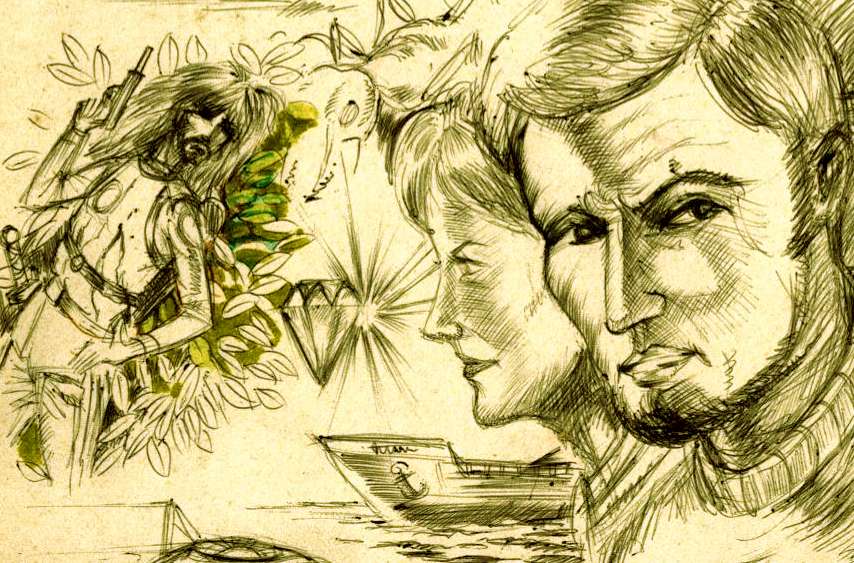
The
clever creature jumped ship, to end up in the United Kngdom, as the
first port of call


Is there any basis of truth in the
"Sectasaur" Antarctic John Storm adventure?
The “Sectasaur” Antarctic John Storm adventure is a work of
fiction, but it is based on some scientific facts and speculations. For
example, the story involves the discovery of a giant prehistoric insect,
resembling a giant ant, that was frozen in the Antarctic ice for
millions of years. This is inspired by the real fossil genus
Titanomyrma, which was a group of giant ants that lived during
the Eocene epoch, about 50 million years ago. Some of these ants were as
big as hummingbirds, and had wingspans of up to 15 cm. They are known
from fossils found in Germany, England, Wyoming, and British
Columbia123. The story also explores the possibility of cross-Arctic
dispersal of thermophilic insects, which means that these ants could
have migrated from Europe to North America via a land bridge that
existed across the Arctic when the climate was warmer. This is a
hypothesis that has been proposed by some paleontologists to explain the
distribution of Titanomyrma and other ancient organisms12. However,
there is no evidence that Titanomyrma or any other giant insect ever
existed in Antarctica, or that they could survive the freezing
temperatures there. The story also involves the use of DNA technology to
recreate and enhance extinct species, which is a controversial and
hypothetical topic that has ethical and ecological implications. The
story is meant to be an entertaining and imaginative adventure, not a
realistic or accurate depiction of paleontology or biology.
1. https://en.wikipedia.org/wiki/Titanomyrma
2. https://interestingengineering.com/science/giant-ant-fossil-life-50-million
3.
https://www.livescience.com/14008-giant-ant-fossil.html


Who are the cast in the Antarctic "Sectasaur" short story?
The Antarctic “Sectasaur” short story is a fictional adventure
that involves the discovery of giant prehistoric ants in Antarctica. The
story has several characters, some of whom are based on real people or
celebrities. Here are some of the main cast members:
- Cathy Carter: She is the leader of an international group of
scientists who are exploring the Antarctic tunnels. She is also a covert
CIA agent who has a secret mission to prevent the Chinese and Swedish
teams from gaining any advantage over the US. She is based on the
actress Scarlett Johansson [1].
- Lin Po Chang: He is the leader of the Chinese team, which is
secretly funded by the Triads. He is a child genius and a martial arts
champion who has a keen interest in paleontology. He is based on the
actor Jet Li [2].
- Bjorn Atlas: He is the leader of the Swedish team, which is
sponsored by a wealthy entrepreneur. He is a headstrong and ambitious
explorer who wants to claim the archaeological prize for himself. He is
based on the actor Alexander Skarsgård [2].
- Sven Johansson: He is the navigator of the Swedish team and
the loyal friend of Bjorn. He is a skilled pilot and a former military
officer. He is based on the actor Joel Kinnaman [2].
- Jimmy Watson: He is a member of Cathy’s team and a former
journalist. He is the one who leaked the information about the tunnel
complex to the media. He is based on the actor Tom Holland [2].
- Dr. Alice Jones: She is a member of Cathy’s team and a
renowned paleontologist. She is the one who identified the fossilized
jaw of the giant ant. She is based on the actress Emma Watson [2].
- Dr. Sam Smith: He is a member of Cathy’s team and a
geneticist. He is the one who extracted the DNA from the fossil and
recreated the giant ant. He is based on the actor Benedict Cumberbatch [2].
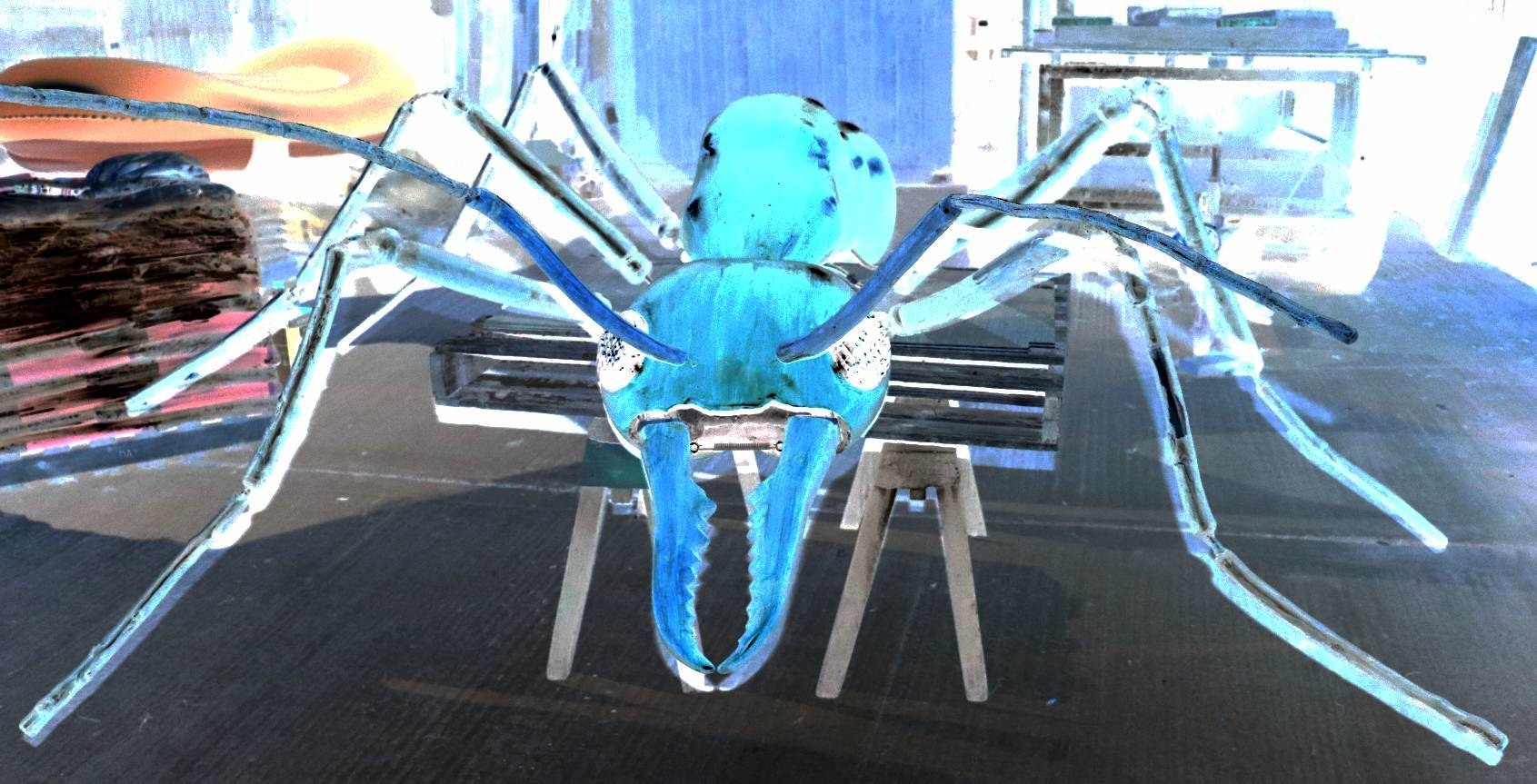

A
nightmare situation, if the Sectasaurs multiplied to threaten other
species on earth
https://www.express.co.uk/news/science/1829824/scientists-reveal-what-made-dinosaurs-extinct
https://www.history.com/topics/pre-history/why-did-the-dinosaurs-die-out-1
https://www.bbc.co.uk/news/science-environment-13269302
https://www.express.co.uk/news/science/1829824/scientists-reveal-what-made-dinosaurs-extinct
https://www.history.com/topics/pre-history/why-did-the-dinosaurs-die-out-1
https://www.bbc.co.uk/news/science-environment-13269302
https://en.wikipedia.org/wiki/Titanomyrma
https://interestingengineering.com/science/giant-ant-fossil-life-50-million
https://www.livescience.com/14008-giant-ant-fossil.html
RETURN
TO BASECAMP
OR EXPLORE OUR
PREHISTORIC A-Z










